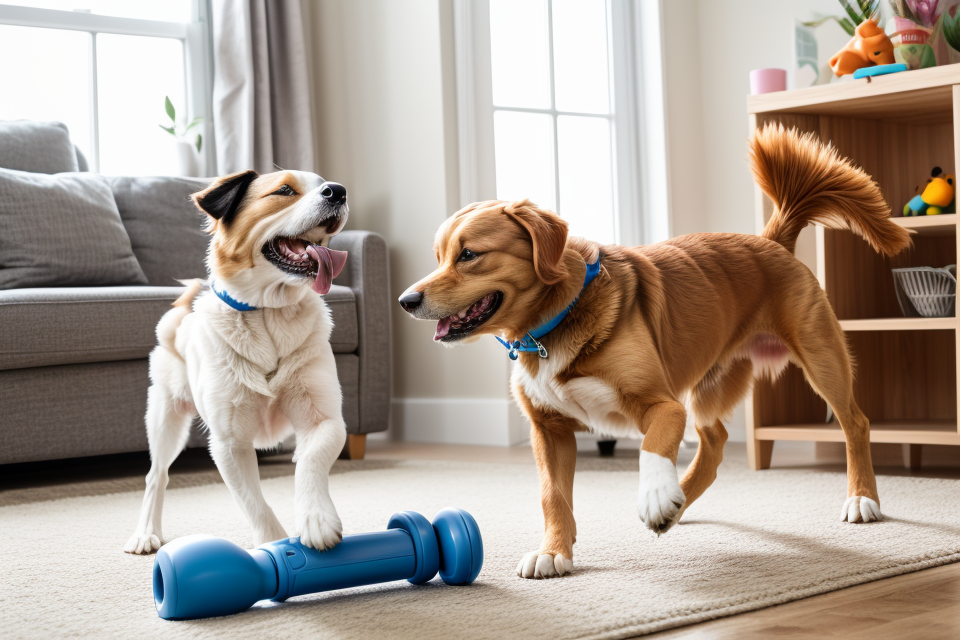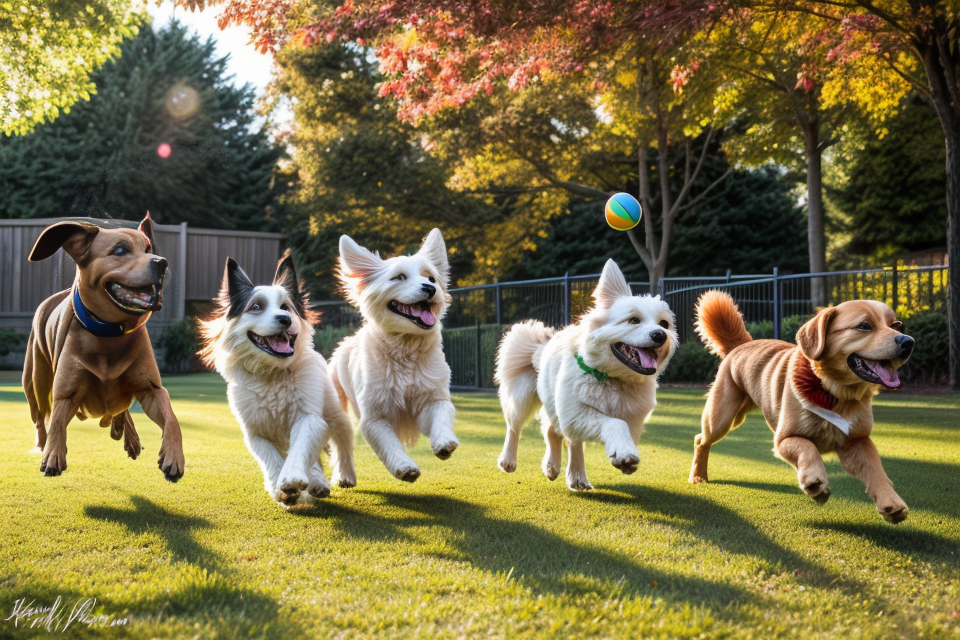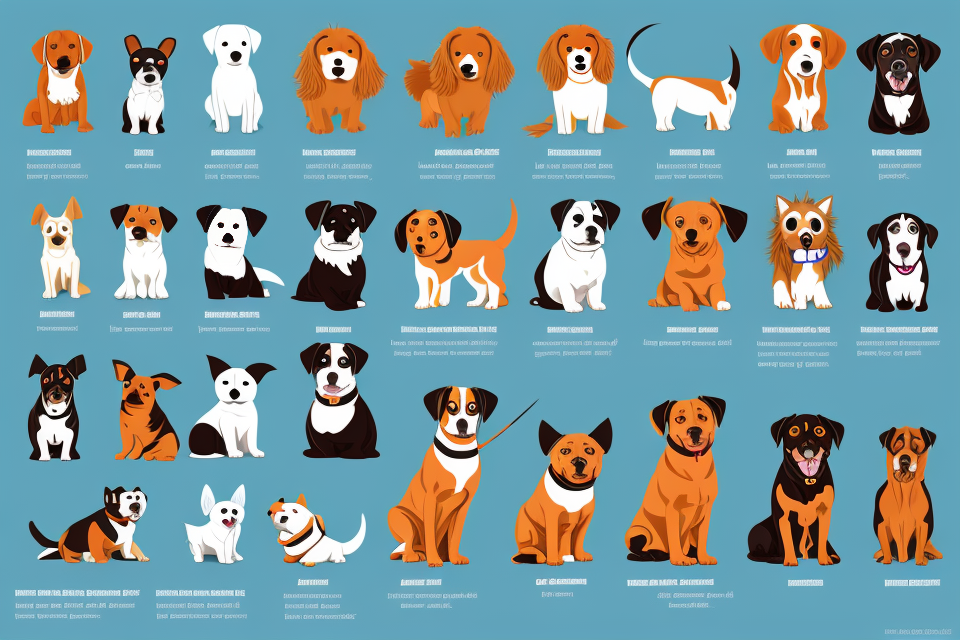Do you ever wonder if squeaky toys are more than just a fun plaything for your furry friend? Some dog owners believe that squeaky toys provide mental stimulation for their pets, but is this really the case? In this article, we will explore the topic of whether squeaky toys can offer mental stimulation for dogs, and examine the science behind this claim. So, whether you’re a dog owner or simply a lover of dogs, read on to discover the truth about whether squeaky toys can provide mental stimulation for man’s best friend.
Yes, mental stimulation for dogs is possible with squeaky toys. Squeaky toys can provide dogs with mental stimulation by encouraging them to use their problem-solving skills to figure out how to get the toy to squeak, and by providing them with auditory stimulation from the sound of the squeaker. Additionally, squeaky toys can help satisfy a dog’s natural instinct to play with and interact with objects, which can help prevent boredom and destructive behavior. However, it’s important to note that squeaky toys should not be the only source of mental stimulation for a dog, and owners should also provide their dogs with a variety of other toys and activities to keep them mentally and physically engaged.
What are squeaky toys?
Definition and purpose
- Squeaky toys are a type of dog toy that is designed to make a squeaking noise when pressed or bitten.
- They are typically made of rubber or plastic and are often small enough to be carried around by dogs.
- Squeaky toys are a popular choice among dog owners because they are relatively inexpensive and easy to find.
- The squeaking noise produced by squeaky toys is thought to be appealing to dogs and can provide mental stimulation.
- Some dogs may become highly attached to their squeaky toys and carry them around with them.
- While squeaky toys can provide some mental stimulation for dogs, they should not be the only source of mental stimulation in a dog’s life.
Materials used in making squeaky toys
Different materials and their benefits/drawbacks
When it comes to squeaky toys, there are a variety of materials that can be used in their construction. These materials can affect the durability, safety, and overall enjoyment of the toy for the dog. Some common materials used in making squeaky toys include:
- Plastic: Plastic is a popular material for squeaky toys because it is durable and can withstand a lot of chewing. It is also lightweight and easy to mold into different shapes and sizes. However, some dogs may be able to break off pieces of the toy and swallow them, which can cause blockages.
- Rubber: Rubber is another durable material that is often used in squeaky toys. It is also flexible and can be molded into different shapes and sizes. However, some dogs may be allergic to rubber or have difficulty chewing through it.
- Vinyl: Vinyl is a synthetic material that is often used in squeaky toys because it is durable and easy to clean. It is also a good option for dogs who are allergic to rubber or plastic. However, some dogs may be able to chew through vinyl and swallow pieces of the toy.
- Fabric: Fabric is a soft material that is often used in squeaky toys for small dogs or puppies. It is also a good option for dogs who are teething, as it can be soothing on their gums. However, fabric toys may not be as durable as other materials and may need to be replaced more frequently.
Potential risks associated with certain materials
When choosing a squeaky toy for your dog, it is important to consider the potential risks associated with certain materials. For example, plastic and rubber toys can pose a choking hazard if your dog is able to break off pieces of the toy and swallow them. Vinyl toys may also pose a choking hazard if your dog is able to chew through them and swallow pieces.
Fabric toys may be a safer option for small dogs or puppies, but they may not be as durable as other materials and may need to be replaced more frequently. It is important to supervise your dog when they are playing with any type of toy and to remove the toy if it becomes damaged or your dog is able to destroy it easily.
In conclusion, the materials used in making squeaky toys can affect the durability, safety, and overall enjoyment of the toy for your dog. It is important to consider the potential risks associated with certain materials and to choose a toy that is appropriate for your dog’s size, chewing ability, and preferences.
The effect of squeaky toys on dog behavior
Positive effects
Squeaky toys can have a range of positive effects on a dog’s behavior. These include:
- Mental stimulation and problem-solving skills: Squeaky toys often require dogs to use their problem-solving skills to figure out how to get the toy to make a noise. This can help keep their minds active and stimulated, which is important for their overall well-being.
- Reduced boredom and increased playtime: Squeaky toys can provide dogs with hours of entertainment, reducing boredom and encouraging them to engage in more playtime. This can help reduce destructive behaviors such as chewing or digging, and can also strengthen the bond between the dog and their owner.
Negative effects
- Aggression and possessiveness
Squeaky toys, while they may provide some level of entertainment for dogs, can also have negative effects on their behavior. One of the most significant issues is that these toys can cause aggression and possessiveness in dogs.
Dogs are naturally territorial, and when they become attached to a particular toy, they may become possessive of it. This possessiveness can lead to aggression towards other dogs or people who attempt to take the toy away from them. This can be particularly problematic in situations where multiple dogs are present, as fights can break out over possession of the toy.
- Destructive behavior
In addition to aggression and possessiveness, squeaky toys can also contribute to destructive behavior in dogs. Many dogs become so engrossed in playing with a squeaky toy that they will chew on it relentlessly, causing damage to the toy and potentially to other objects in their environment. This destructive behavior can be particularly problematic if the dog is left alone with the toy for extended periods of time, as they may become increasingly frustrated and destructive in their efforts to get to the squeaker inside the toy.
It is important to note that not all dogs will exhibit these negative behaviors in response to squeaky toys. However, it is worth considering the potential risks associated with these toys, particularly if you have a dog who is prone to aggression or destructive behavior. If you do choose to give your dog a squeaky toy, it is important to supervise their play and to provide plenty of other toys and forms of mental stimulation to prevent them from becoming overly fixated on the squeaky toy.
Can all dogs benefit from squeaky toys?
Breed-specific considerations
When it comes to the question of whether all dogs can benefit from squeaky toys, the answer is not so straightforward. Some dogs may find squeaky toys irresistible and be highly motivated to play with them, while others may not be as interested. This may depend on several factors, including the dog’s age, breed, and individual personality.
Breeds that may be more likely to benefit from squeaky toys
Certain breeds may be more likely to enjoy playing with squeaky toys than others. For example, terrier breeds such as the Jack Russell Terrier and the Scottish Terrier are known for their curiosity and love of digging, which may make them particularly interested in toys that make noise. Other breeds that may enjoy squeaky toys include Beagles, Basset Hounds, and Chihuahuas.
Breeds that may not be as interested in squeaky toys
On the other hand, some breeds may not be as interested in squeaky toys as others. For example, larger breeds such as German Shepherds and Golden Retrievers may not be as attracted to small, high-pitched noises and may prefer toys that are more interactive or offer more physical stimulation. Other breeds that may not be as interested in squeaky toys include Greyhounds, Afghan Hounds, and Borzois.
It’s important to note that these are generalizations and every dog is an individual. While some breeds may be more likely to enjoy squeaky toys, there is no guarantee that every dog within that breed will be equally interested. Additionally, individual personalities and experiences can play a significant role in a dog’s interest in squeaky toys. Ultimately, the best way to determine whether a dog will enjoy a squeaky toy is to observe their behavior and preferences.
Age-specific considerations
Puppies vs. adult dogs
While squeaky toys can be engaging for many dogs, the age of the dog plays a significant role in determining the effectiveness of these toys as mental stimulation. For puppies, squeaky toys can serve as a source of entertainment and can help in developing their auditory skills. Puppies have a natural inclination to explore and investigate new objects, and squeaky toys can be an excellent tool to stimulate their curiosity.
On the other hand, adult dogs may have different preferences when it comes to squeaky toys. While some adult dogs may find them entertaining, others may become bored with them quickly. Adult dogs may require more complex and challenging toys to provide adequate mental stimulation. However, squeaky toys can still be a part of an adult dog’s toy collection, and they can be rotated with other toys to keep the dog engaged.
Senior dogs and their needs
Senior dogs have unique needs, and squeaky toys may not be the most effective mental stimulation for them. Senior dogs may have physical limitations that prevent them from playing with toys as actively as younger dogs. In addition, their hearing and vision may not be as sharp as they used to be, making it difficult for them to appreciate the sound of a squeaky toy.
However, there are other types of toys that can provide mental stimulation for senior dogs. For example, puzzle toys that require them to use their cognitive abilities to figure out how to get a treat can be a great way to keep their minds active. In addition, interactive games such as hide-and-seek or scent work can be a fun way to provide mental stimulation for senior dogs.
Overall, while squeaky toys can be a fun and engaging tool for mental stimulation for some dogs, it is essential to consider the age of the dog and their individual preferences and needs.
Other factors to consider
Size and shape of the toy
When it comes to choosing a squeaky toy for your dog, it’s important to consider the size and shape of the toy. While small squeaky toys may be more affordable and convenient, they can also pose a choking hazard for smaller dogs. On the other hand, larger squeaky toys may be more durable and withstand more playtime, but they may also be too large for smaller dogs to handle.
Choosing the right size for your dog is crucial to ensuring their safety and enjoyment while playing with the toy. If you have a small dog, it’s best to choose a squeaky toy that is specifically designed for smaller dogs. These toys are typically made with smaller, softer materials that are less likely to cause choking, and they are often designed to be easily gripped by smaller paws.
It’s also important to consider the shape of the toy. Some squeaky toys have small parts or pieces that can easily break off and pose a choking hazard. It’s important to choose a toy that is made with sturdy materials and has no small parts that can be easily detached.
In addition to safety concerns, the size and shape of the toy can also impact how much mental stimulation it provides for your dog. Smaller, flatter toys may be easier for dogs to manipulate and can provide more opportunities for mental stimulation, while larger, more complex toys may be more entertaining but may not provide as much mental stimulation.
Ultimately, when choosing a squeaky toy for your dog, it’s important to consider their size, temperament, and play style. By choosing a toy that is the right size and shape for your dog, you can help ensure their safety and provide them with the mental stimulation they need to stay happy and healthy.
Frequency and duration of playtime
How often to give your dog access to the toy
Providing your dog with regular access to squeaky toys is crucial for their mental stimulation. However, it is essential to avoid overuse and ensure that the toy remains engaging. A general guideline is to offer the toy for play sessions 2-3 times per day, for short durations of 10-15 minutes each. This frequency and duration can be adjusted based on your dog’s individual needs and preferences.
Setting limits and avoiding overuse
While squeaky toys can provide mental stimulation for dogs, it is important to set limits and avoid overuse. Excessive play with squeaky toys can lead to boredom and a lack of interest in other forms of mental stimulation. Therefore, it is recommended to rotate the toys with other forms of mental stimulation, such as puzzle toys, training sessions, and interactive games. Additionally, monitoring your dog’s behavior and adjusting the frequency and duration of playtime accordingly can help prevent overuse and maintain your dog’s interest in the toy.
Alternatives to squeaky toys for mental stimulation
Food-based puzzles
Food-based puzzles are an alternative way to provide mental stimulation for dogs. These puzzles involve hiding food or treats in a toy or container that the dog must figure out how to access. This type of puzzle can be beneficial for dogs as it encourages them to use their problem-solving skills and can help satisfy their natural instinct to forage for food.
There are several types of food-based puzzles available for dogs, including:
- Hide and seek toys: These toys have small openings where food can be hidden, and the dog must use their nose or paws to extract the food.
- Interactive feeders: These are devices that dispense food or treats when the dog interacts with the toy, such as shaking it or pushing a button.
- Puzzle toys: These are toys that have compartments or slots where food can be hidden, and the dog must figure out how to access them.
When choosing a food-based puzzle for your dog, it’s important to consider their size, strength, and intelligence. Some puzzles may be too easy or too difficult for certain dogs, so it’s important to choose one that is appropriate for your dog’s abilities. It’s also important to supervise your dog while they are using the puzzle to ensure they don’t choke or have any other adverse reactions.
Overall, food-based puzzles can be a fun and engaging way to provide mental stimulation for dogs. They can help keep dogs mentally active and satisfied, and can also help prevent boredom and destructive behaviors.
Interactive games and activities
Training and obedience
One of the most effective ways to mentally stimulate dogs is through training and obedience. This involves teaching dogs basic commands such as sit, stay, come, and heel. These commands not only improve a dog’s obedience but also strengthen the bond between the dog and its owner. Additionally, training and obedience can help prevent behavioral problems such as barking, chewing, and digging.
Scent work and tracking
Scent work and tracking are excellent activities for mentally stimulating dogs. This involves using a dog’s sense of smell to find hidden objects or search for a specific scent. It can be as simple as hiding a toy or treat and letting the dog find it, or as complex as training a dog to search for a specific scent in a variety of environments. Scent work and tracking can improve a dog’s problem-solving skills, memory, and focus.
Agility and nose work
Agility and nose work are physically and mentally stimulating activities for dogs. Agility involves navigating an obstacle course that includes tunnels, jumps, and weave poles. This activity improves a dog’s physical fitness, coordination, and focus. Nose work involves using a dog’s sense of smell to find hidden objects or search for a specific scent. This activity can be done in a variety of environments, including homes, parks, and even in the car. Agility and nose work can improve a dog’s problem-solving skills, memory, and focus.
FAQs
1. What are squeaky toys?
Squeaky toys are toys designed for dogs that make a squeaking noise when they are squeezed or chewed on. These toys are often made of rubber or plastic and are small enough for dogs to carry around in their mouths.
2. Do squeaky toys provide mental stimulation for dogs?
Squeaky toys can provide some mental stimulation for dogs, especially if they are filled with treats or hidden in a puzzle toy. However, squeaky toys are not as mentally stimulating as other types of toys, such as interactive puzzle toys or dog games that require problem-solving skills.
3. Are squeaky toys a substitute for mental stimulation?
No, squeaky toys should not be used as a substitute for mental stimulation. While they can provide some mental stimulation, they are not as effective as other types of toys and activities that are specifically designed to challenge a dog’s mind.
4. Are squeaky toys appropriate for all dogs?
Squeaky toys can be appropriate for most dogs, but it is important to supervise their play and ensure that they are not swallowing the toy or any small pieces that may break off. Some dogs may also become aggressive or possessive of their squeaky toys, so it is important to monitor their behavior and intervene if necessary.
5. Can squeaky toys be used as a reward or training tool?
Yes, squeaky toys can be used as a reward or training tool. Dogs can be trained to perform certain behaviors in exchange for a squeaky toy, or a squeaky toy can be used as a reward for good behavior during training sessions. This can help to reinforce positive behavior and strengthen the bond between the dog and their owner.



